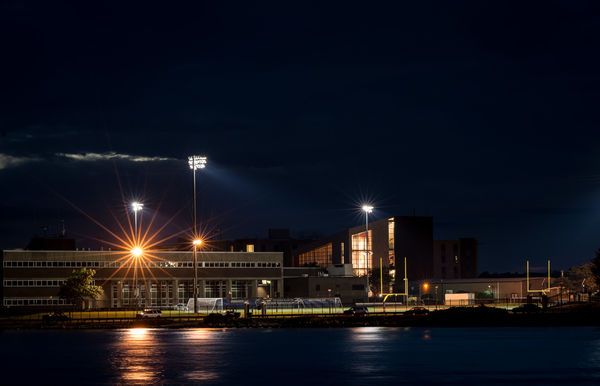Check out Video for DSLR and Point and Shoot Cameras section of our forum.
Diffraction, done a search, nothing.
Dec 2, 2016 23:40:10 #
Haveago wrote:
Hi Gene, to be honest I'm not sure, I understand the concept but not sure how to express it as a photo. One of my photo club competitions is to show diffraction in a photo.
My question is how can I best do that?
Baz
My question is how can I best do that?
Baz
Are you sure they are even talking about the small aperture thing? "Disfraction" has a more general definition that could include for example the rainbow or the spectrum effect from a cut crystal wine glass.
Dec 2, 2016 23:57:14 #
FAQ: How to Avoid Small Aperture Diffraction In Photography at http://www.uglyhedgehog.com/t-284491-1.html
FAQ: Why are my Digital Images Sharper at f/8 than f/22? at http://www.uglyhedgehog.com/t-59819-1.html
FAQ: Why are my Digital Images Sharper at f/8 than f/22? at http://www.uglyhedgehog.com/t-59819-1.html
Dec 3, 2016 00:42:00 #
Aren't the "stars" that result from having a bright light in a photograph a result of diffraction?
Check out Street Photography section of our forum.
Dec 3, 2016 04:27:13 #
I wrote an article about diffraction for my camera club's newsletter once. I photographed a computer circuit board for my test photos because I thought the detail might show the effects of diffraction. I went to a computer repair store and they gave me a circuit board they had no use for. Photos become softer very gradually as you stop down the aperture. I shot the top one at f/11, the middle one at f/29, and the bottom one at f/36. My Nikon 16-85mm lens has an aperture range of f/5.6 - f/36 when set at 85mm.
Dec 3, 2016 07:03:05 #
Use the smallest aperture that your lens is capable of and photograph something that has lots of sharp, high contrast edges or high contrast detail. It might be an idea to include sharp text of some sort. And shoot raw rather than jpeg. In PP you can cheat a bit by cropping, don't use sharpening and use denoise to soften. If that results in the image looking over-soft you can add Contrast or Clarity to add some vividness while at the same time preserving the softness of the edges.
Dec 3, 2016 07:42:53 #
rehess wrote:
Aren't the "stars" that result from having a bright light in a photograph a result of diffraction?
Yes. See examples below.
It is important that your lenses are absolutely clean.
Dec 3, 2016 07:54:50 #
Check out Street Photography section of our forum.
Dec 3, 2016 08:27:31 #
rehess wrote:
Aren't the "stars" that result from having a bright light in a photograph a result of diffraction?
The star shapes are a form of diffraction according to this article:
http://photo.stackexchange.com/questions/6605/why-do-light-sources-appear-as-stars-sometimes
Dec 3, 2016 08:35:30 #
zigipha
Loc: north nj
Difraction shows up several ways - the fuzziness of super stopped down photos (as shown above); star bursts (as shown above).
the rainbow on the pink floyd cover is dispersion
There is also chromatic aberration, a form of diffraction, which can be seen when you have a bright light (sky) and a sharp edge of an object (dark), you see (often) purple fringe lines at the transition (on the dark side of the edge). This can often be corrected for with s/w
Diffraction happens when light "bends" around a sharp corner. Dispersion is the due to different velocities of different wavelengths as light passes through a medium (rainbow)
the rainbow on the pink floyd cover is dispersion
There is also chromatic aberration, a form of diffraction, which can be seen when you have a bright light (sky) and a sharp edge of an object (dark), you see (often) purple fringe lines at the transition (on the dark side of the edge). This can often be corrected for with s/w
Diffraction happens when light "bends" around a sharp corner. Dispersion is the due to different velocities of different wavelengths as light passes through a medium (rainbow)
Dec 3, 2016 09:47:19 #
zigipha wrote:
Difraction shows up several ways - the fuzziness o... (show quote)
Actually, the inability of a lens to correctly focus all wavelengths of visible light at the same plane, which causes purple, green/cyan and/or magenta fringing is caused by a lens not properly corrected for axial chromatic aberration. This is a refraction phenomenon, not diffraction. When you get fringing it's because that color is actually focusing on a different plane than the rest of the image, so you are seeing colored "ghosting."
Diffraction effects increase with smaller apertures - lenses get softer, star patterns become better defined. When you have CA, stopping the lens down a few stops does the opposite - it minimizes and in some cases eliminates the fringing.
Dec 3, 2016 10:15:37 #
Haveago wrote:
Ok I've read up on diffraction but not found an answer as to how it might be transposed/shown/taken as a photograph?
Any help much happreciated.
Thanks
Baz
Any help much happreciated.
Thanks
Baz
Record a scene on a high megapixel APS-C camera at f/5.6, using an f/2.8 maximum aperture lens. Re-balance the exposure and record the same scene at f22 (f/32 if that is an option on your lens). Compare...
You may need an ND filter and a tripod to do this.
The f/5.6 scene will be sharp at the point of focus, with near-optimal contrast and moderate depth of field. The small aperture scene will have extreme depth of field, reduced contrast, reduced detail resolution, and a softer appearance overall.
Dec 3, 2016 11:19:09 #
Thank you for posting these wonderful references.
I had been looking for something like this to apply to macrophotography.
When I used Kodachrome Type A, I calculated that its resolution (? 200lines/inch) just matched the lens resolution at F-16 at RR=1:4, and so for most macro shots, this combination was getting all the resolution available.
So for a digital camera, would F-16 be an optimal aperture where maximum DoF and resolution are required? ( at RR=1:6 down to RR=1:2)
Could you tell me if the digital image would equal or exceed the Kodachrome one? The loss of resolution at RR=1:1 from F-16 to F-32 with an anatomic specimen- a pale gray organ (mouse male reproductive system) is very obvious with color transparency film.
Comment?
I had been looking for something like this to apply to macrophotography.
When I used Kodachrome Type A, I calculated that its resolution (? 200lines/inch) just matched the lens resolution at F-16 at RR=1:4, and so for most macro shots, this combination was getting all the resolution available.
So for a digital camera, would F-16 be an optimal aperture where maximum DoF and resolution are required? ( at RR=1:6 down to RR=1:2)
Could you tell me if the digital image would equal or exceed the Kodachrome one? The loss of resolution at RR=1:1 from F-16 to F-32 with an anatomic specimen- a pale gray organ (mouse male reproductive system) is very obvious with color transparency film.
Comment?
Dec 3, 2016 12:03:00 #
mmcgavin wrote:
...So for a digital camera, would F-16 be an optimal aperture where maximum DoF and resolution are required? ( at RR=1:6 down to RR=1:2)...
If it were me i would open the lens up to f5.6 or f8 to recover resolution, bias the exposure to increase the
dynamic headroom on the light greys and play with some UV and red filters.
Dec 3, 2016 12:34:31 #
mmcgavin wrote:
I'm not sure I understand what these resolution measurements actually tell us. Back in the days of film, I was a regular user of Kodachrome 25. When I was thinking about moving to digital, I sent some carefully selected Kodachrome 25 slides to a professional to be scanned; when I say "carefully selected" I mean they had some kind of fine detail, such as railroad cars with lettering that could barely be read, indoors shots including books and other reading material in which the letters could barely be read, etc. When I got the scans back, I set myself up in the "library", the room in the house where our computer was located, so I could project slides and simultaneously look at the scans; I would project a slide, and then take a plain piece of cardboard up to the screen {so the grain of the reflective beads on the screen wouldn't be an issue} and moved it back-and-forth to be sure I had the point of perfect focus of the projected image. I used that method to compare projected slide with scanned slide, comparing each selected detail on the two versions of the slide. Every compared detail detail looked as good on the scanned image as it did on the projected image. Thank you for posting these wonderful references. ... (show quote)
I didn't mention this earlier, but the scanned images were 3000 x 2000. I summarized my research by saying "at the level of lenses I am willing to buy, an image with at least 3000 pixels horizontally will provide images as good as I've been getting from Kodachrome" {I specified it that way, because I wanted to eliminate 4:3 6MP images} Eighteen months ago, I purchased a Pentax K-30. The camera I had used to take most of the images used in my experiment had been a Pentax Super Program, so now for the first time I was able to mount the lens used to take those pictures on a digital camera. I was surprised to discover that pictures taken with the old lens, a Pentax-A 50mm f/1.7 lens, on a 16MP digital camera gave much better sharper pictures than I had ever gotten with Kodachrome 25, so I no longer include the "at the level of lenses I am willing to buy" disclaimer on my statement.
Dec 3, 2016 13:23:55 #
mmcgavin wrote:
Thank you for posting these wonderful references. ... (show quote)
I'm not being flip about it when I say you need to make your own tests. As I mentioned above, a combination of properties combine to determine optimal aperture and the point where diffraction begins to limit sharpness.
It probably isn't f/16... the smaller the sensor, the wider the aperture needs to be to avoid diffraction. That's because smaller sensors have denser pixel spacing and smaller sensor sites. It's also because lens performance most often peaks around 2 to 3 stops down from wide open. ALL my f/2.8 lenses are best at f/5.6, and pretty poor at f/16. Your experience may vary.
If you want to reply, then register here. Registration is free and your account is created instantly, so you can post right away.
Check out Photo Critique Section section of our forum.













